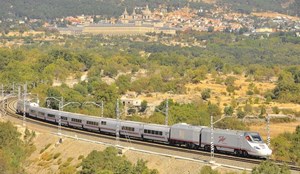News
Ten Spanish companies join forces to apply H2 propulsion to a high-speed train
Ten Spanish companies have joined forces to design, build and install, for the first time in the world, a propulsion system based on renewable H2 fuel cells on a high-speed train. Under the Hympulso project, the companies will develop a set of technologies that can be applied to the Talgo 250 'all-terrain' train, making it possible to electrify the rail network with energy generated entirely from renewable sources, even on lines without overhead power lines.
Led by Talgo, Hympulso also includes Golendus, Ingeteam, Optimus3D, Repsol and Sener as partners. Universidad Pontificia Comillas and Tecnalia are collaborators, while Adif is an observer. The initiative has received a grant of €6.5 MM and is part of the Incentive Program for the Innovative Value Chain and Knowledge of Renewable H2, as part of the Recovery, Transformation and Resilience Plan.
Hympulso will be comprehensive in nature: it will activate the entire renewable H2 value chain in the railway system, from production to consumption. The project will also make it possible to analyze the impact of the future transition on the various railway infrastructure assets managed by Adif, such as maintenance facilities or the track.
Thus, the project will result in a joint output of H2 supply installations adapted to railways -both mobile and static- and a pioneering prototype of a hybrid bimodal train for passengers with automatic track-gauge change, which will be able to run both on conventional and high-speed networks, using catenary supply when available, or H2 and batteries in those corridors that are not electrified.
This holistic perspective is key because tackling the many major technological challenges posed by the adoption of renewable H2 in rail transport will require the involvement of multiple stakeholders at all levels, and from both the public and private sectors.
All project partners seek to evolve their enabling technologies and expertise in the field of renewable H2 with Hympulso. Talgo's objective will thus be to develop, manufacture and test dual-hybrid H2 battery traction on a Talgo 250 train, intended for long-distance operations on mixed sections: partially electrified and partially non-electrified.
Called Talgo 250, these trains have two technical end cars each (CET), which are currently used to generate electricity from diesel to power the traction units on sections without catenary. Under the Hympulso project, one of these diesel CETs will be replaced in a Talgo 250 unit by one equipped with fuel cells and batteries to supply electricity to the locomotives using 100% green, renewable H2.
Ingeteam will design, manufacture and test reversible high-power converters, capable of charging the batteries from the catenary. Repsol and Golendus will be responsible for developing two H2 refueling facilities. Repsol will deploy a mobile facility, while Golendus' H2 plant will be a static production and supply facility. For the H2 supply facilities and the railway infrastructure, Sener will carry out an overall risk analysis and a simulation of the operation of the services. In both cases, a logistics control platform will be developed to monitor the use of H2 in the network.
Finally, an SME, the Alava-based Optimus3D will work on more efficient and durable new materials, based on additive manufacturing, and new processes to be used in H2 applications.
As for the observer companies, Adif wants to develop its knowledge in the definition of requirements and use cases in the access to the railway infrastructure of H2 technology. It will develop the safety requirements associated with the infrastructure and the interfaces with vehicle and refueling facility, as well as the design of standardized refueling facilities and collaborate with the use cases on the H2 fueling platform.
Adif will also include the comprehensive management of this new fuels within its wider H2 strategy; furthermore, it will contribute during track testing by easing the access to the rail infrastructure.
The Hympulso project is part of the 'Value chain: design, demonstration and validation of H2-powered mobility' call, which forms part of the Strategic Projects for Economic Recovery and Transformation (PERTE) for renewable energies, renewable H2 and storage (ERHA). In the resolution of the call for proposals, this project received the highest score for the soundness of its technical proposal and its innovative nature.
Under the PERTE designation, a sector is identified as a key area for the future of the economy. In total, twelve strategic projects have been approved in areas such as the development of electric and connected vehicles, renewable energies, renewable H2 and storage, cutting-edge health, the agri-food sector, the new language economy, the circular economy model, the shipbuilding industry, aerospace, the digitization of the water cycle, microchips, the social and care economy and the decarbonization of industry.


